SABS AQP_Process_Training
dp training过程

dp training过程DP训练过程DP(Differentiable Programming)训练过程是一种基于微分的学习方法,通过对神经网络进行迭代优化,以解决不同任务的问题。
在DP训练过程中,我们通过通过反向传播算法来计算网络参数的梯度,并根据梯度更新参数,以最小化损失函数。
首先,在DP训练过程中,我们需要明确定义任务的目标和相关的数据集。
例如,如果我们要解决图像分类问题,我们需要准备一个包含标注的图像数据集作为训练样本。
接下来,我们需要设计一个神经网络模型来解决所给定的任务。
神经网络通常由多个层组成,包括输入层、隐藏层和输出层。
每个层中的神经元通过非线性函数进行计算,从而得到输出结果。
然后,我们需要定义一个损失函数来度量网络输出与真实标签之间的差异。
通常使用交叉熵损失函数来衡量分类任务中的差异。
我们的目标是通过优化损失函数来使网络的输出在训练集上尽可能接近于真实标签。
在DP训练过程中,我们使用反向传播算法来计算损失函数对于网络参数的梯度。
通过将梯度向后传播到网络的每一层,我们可以相应地更新每个参数,以使损失函数逐步减小。
为了实现这一点,我们需要选择一个优化器来更新网络参数。
常见的优化算法包括梯度下降(Gradient Descent)、动量(Momentum)、自适应学习率算法(Adam)等。
这些算法根据梯度的方向和大小来更新参数,并以不同的速率进行调整。
在训练过程中,我们将训练数据分为小批量进行处理,称为批量梯度下降。
这是为了充分利用计算资源并减少训练过程中的计算量。
每个批次都会进入网络,计算预测输出和损失,并通过反向传播更新参数。
最后,我们通过迭代训练过程中不同的批次,直到达到预定的迭代次数。
每个训练迭代都会逐步减小损失函数,直至收敛到最优解。
收敛时,网络可以产生准确的输出,并可以用于对新数据进行预测或分类。
在DP训练过程中,我们需要关注过拟合问题。
过拟合是指网络在训练集上表现良好,但在测试集上表现较差的现象。
安全强化学习综述
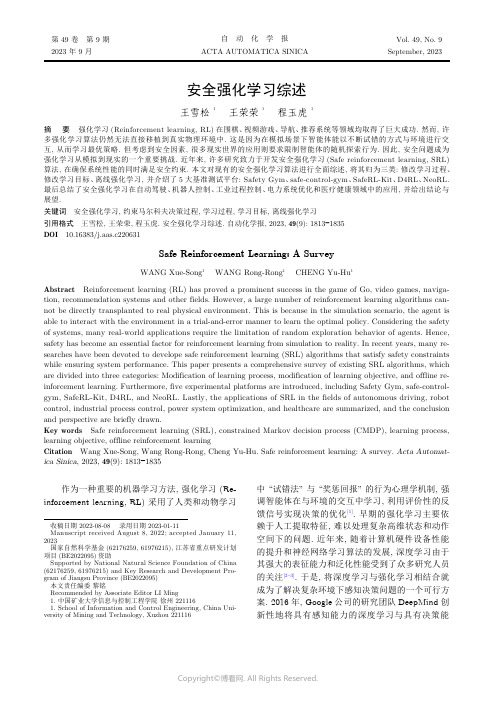
安全强化学习综述王雪松 1王荣荣 1程玉虎1摘 要 强化学习(Reinforcement learning, RL)在围棋、视频游戏、导航、推荐系统等领域均取得了巨大成功. 然而, 许多强化学习算法仍然无法直接移植到真实物理环境中. 这是因为在模拟场景下智能体能以不断试错的方式与环境进行交互, 从而学习最优策略. 但考虑到安全因素, 很多现实世界的应用则要求限制智能体的随机探索行为. 因此, 安全问题成为强化学习从模拟到现实的一个重要挑战. 近年来, 许多研究致力于开发安全强化学习(Safe reinforcement learning, SRL)算法, 在确保系统性能的同时满足安全约束. 本文对现有的安全强化学习算法进行全面综述, 将其归为三类: 修改学习过程、修改学习目标、离线强化学习, 并介绍了5大基准测试平台: Safety Gym 、safe-control-gym 、SafeRL-Kit 、D4RL 、NeoRL.最后总结了安全强化学习在自动驾驶、机器人控制、工业过程控制、电力系统优化和医疗健康领域中的应用, 并给出结论与展望.关键词 安全强化学习, 约束马尔科夫决策过程, 学习过程, 学习目标, 离线强化学习引用格式 王雪松, 王荣荣, 程玉虎. 安全强化学习综述. 自动化学报, 2023, 49(9): 1813−1835DOI 10.16383/j.aas.c220631Safe Reinforcement Learning: A SurveyWANG Xue-Song 1 WANG Rong-Rong 1 CHENG Yu-Hu 1Abstract Reinforcement learning (RL) has proved a prominent success in the game of Go, video games, naviga-tion, recommendation systems and other fields. However, a large number of reinforcement learning algorithms can-not be directly transplanted to real physical environment. This is because in the simulation scenario, the agent is able to interact with the environment in a trial-and-error manner to learn the optimal policy. Considering the safety of systems, many real-world applications require the limitation of random exploration behavior of agents. Hence,safety has become an essential factor for reinforcement learning from simulation to reality. In recent years, many re-searches have been devoted to develope safe reinforcement learning (SRL) algorithms that satisfy safety constraints while ensuring system performance. This paper presents a comprehensive survey of existing SRL algorithms, which are divided into three categories: Modification of learning process, modification of learning objective, and offline re-inforcement learning. Furthermore, five experimental platforms are introduced, including Safety Gym, safe-control-gym, SafeRL-Kit, D4RL, and NeoRL. Lastly, the applications of SRL in the fields of autonomous driving, robot control, industrial process control, power system optimization, and healthcare are summarized, and the conclusion and perspective are briefly drawn.Key words Safe reinforcement learning (SRL), constrained Markov decision process (CMDP), learning process,learning objective, offline reinforcement learningCitation Wang Xue-Song, Wang Rong-Rong, Cheng Yu-Hu. Safe reinforcement learning: A survey. Acta Automat-ica Sinica , 2023, 49(9): 1813−1835作为一种重要的机器学习方法, 强化学习 (Re-inforcement learning, RL) 采用了人类和动物学习中 “试错法” 与 “奖惩回报” 的行为心理学机制, 强调智能体在与环境的交互中学习, 利用评价性的反馈信号实现决策的优化[1]. 早期的强化学习主要依赖于人工提取特征, 难以处理复杂高维状态和动作空间下的问题. 近年来, 随着计算机硬件设备性能的提升和神经网络学习算法的发展, 深度学习由于其强大的表征能力和泛化性能受到了众多研究人员的关注[2−3]. 于是, 将深度学习与强化学习相结合就成为了解决复杂环境下感知决策问题的一个可行方案. 2016年, Google 公司的研究团队DeepMind 创新性地将具有感知能力的深度学习与具有决策能收稿日期 2022-08-08 录用日期 2023-01-11Manuscript received August 8, 2022; accepted January 11,2023国家自然科学基金(62176259, 61976215), 江苏省重点研发计划项目(BE2022095)资助Supported by National Natural Science Foundation of China (62176259, 61976215) and Key Research and Development Pro-gram of Jiangsu Province (BE2022095)本文责任编委 黎铭Recommended by Associate Editor LI Ming1. 中国矿业大学信息与控制工程学院 徐州 2211161. School of Information and Control Engineering, China Uni-versity of Mining and Technology, Xuzhou 221116第 49 卷 第 9 期自 动 化 学 报Vol. 49, No. 92023 年 9 月ACTA AUTOMATICA SINICASeptember, 2023力的强化学习相结合, 开发的人工智能机器人Al-phaGo 成功击败了世界围棋冠军李世石[4], 一举掀起了深度强化学习的研究热潮. 目前, 深度强化学习在视频游戏[5]、自动驾驶[6]、机器人控制[7]、电力系统优化[8]、医疗健康[9]等领域均得到了广泛的应用.近年来, 学术界与工业界开始逐步注重深度强化学习如何从理论研究迈向实际应用. 然而, 要实现这一阶段性的跨越还有很多工作需要完成, 其中尤为重要的一项任务就是保证决策的安全性. 安全对于许多应用至关重要, 一旦学习策略失败则可能会引发巨大灾难. 例如, 在医疗健康领域, 微创手术机器人辅助医生完成关于大脑或心脏等关键器官手术时, 必须做到精准无误, 一旦偏离原计划位置, 则将对病人造成致命危害. 再如, 自动驾驶领域, 如果智能驾驶车辆无法规避危险路障信息, 严重的话将造成车毁人亡. 因此, 不仅要关注期望回报最大化,同时也应注重学习的安全性.García 和Fernández [10]于2015年给出了安全强化学习 (Safe reinforcement learning, SRL) 的定义: 考虑安全或风险等概念的强化学习. 具体而言,所谓安全强化学习是指在学习或部署过程中, 在保证合理性能的同时满足一定安全约束的最大化长期回报的强化学习过程. 自2015年起, 基于此研究,学者们提出了大量安全强化学习算法. 为此, 本文对近年来的安全强化学习进行全面综述, 围绕智能体的安全性问题, 从修改学习过程、修改学习目标以及离线强化学习三方面进行总结, 并给出了用于安全强化学习的5大基准测试平台: Safety Gym 、safe-control-gym 、SafeRL-Kit 、D4RL 、NeoRL, 以及安全强化学习在自动驾驶、机器人控制、工业过程控制、电力系统优化以及医疗健康领域的应用.安全强化学习中所涉及的方法、基准测试平台以及应用领域之间的关系如图1所示.本文结构如下: 第1节对安全强化学习问题进行形式化描述; 第2节对近年来的安全强化学习方法进行分类与综述; 第3节介绍5种基准测试平台;第4节总结安全强化学习的实际应用场景; 第5节对未来研究方向进行探讨; 第6节对文章进行总结.1 问题描述M ∪C M =⟨S ,A ,T ,γ,r ⟩C ={c,d }S A T (s ′|s,a )γr :S ×A →R c :S ×A →R d π∗安全强化学习问题通常被定义为一个约束马尔科夫决策过程 (Constrained Markov decision pro-cess, CMDP) [11], 即在标准马尔科夫决策过程 的基础上添加了关于成本函数的约束项 . 表示状态空间集, 表示动作空间集, 表示用于描述动力学模型的状态转移函数, 表示折扣因子, 表示奖励函数; 表示成本函数, 表示安全阈值. 这种情况下, 安全强化学习问题可以表述为在满足安全约束的情况下, 求解使期望回报最大化的最优可行策略J (π)=E τ∼π(∞t =0γtr (s t ,a t ))τ=(s 0,a 0,s 1,a 1,···)τ∼πτπΠc 其中, , 表示一条轨迹, 表示轨迹 根据策略 采样得到, 表示满足安全约束的安全策略集. 值得注意的是, 本文公式所描述的都是单成本约束的形式, 但不失一般性, 这些公式都可以拓展为多成本约束的形式. 对于不同类型的决策任务,安全策略集可以有不同的表达形式.Πc 对于安全性要求严格的决策任务, 例如自动驾驶[12−13]任务, 通常采用硬约束方式, 即在所有的时刻都需要强制满足单步约束. 这种情况下 表示为环境知识人类知识无先验知识拉格朗日法信赖域法策略约束值约束预训练模型图 1 安全强化学习方法、基准测试平台与应用Fig. 1 Methods, benchmarking platforms, and applications of safe reinforcement learning1814自 动 化 学 报49 卷Π其中, 表示可行策略集. 但由于这种约束方式要求过于严格, 因此通常需要借助模型信息加以实现.Πc 在无模型情况下, 软约束方式有着更广泛的应用, 即对折扣累积成本的期望进行约束, 这种情况下 表示为c :S ×A →{0,1}c (s t ,a t )=0c (s t ,a t )=1E τ∼π(∑∞t =0γtc (s t ,a t ))π这种约束方式可以很好地适用于机器人行走[14]、油泵安全控制[15]和电力系统优化[16]等任务, 但对于需要明确定义状态或动作是否安全的任务却难以处理. 为了使软约束方式更好地适用于不同类型的决策任务, 可以将成本函数修改为 ,利用成本函数对当前状态动作对进行安全性判断,若安全, 则 , 否则, , 并且在智能体与环境交互期间遇到不安全的状态动作对时终止当前回合. 这时, 约束项 可以表示 产生不安全状态动作对的概率, 因此经过这样修改后的软约束也被称为机会型约束. 机会型约束由于其良好的任务适应性, 已被成功应用于无模型的自动驾驶[17]和机械臂控制[18]等任务.M =⟨S ,A ,T ,γ,r ⟩π∗=arg max π∈ΠJ (π)B ={(s,a,r,s ′)}π∗另一方面, 离线强化学习[19−20]从一个静态的数据集中学习最优策略, 它避免了与环境的交互过程,可以保障训练过程中的安全性. 因此, 可以将离线强化学习作为安全强化学习的一种特殊形式. 离线强化学习考虑一个标准马尔科夫决策过程 , 它的目标是求解使期望回报最大化的最优可行策略 , 与在线方式不同的是, 智能体在训练过程中不再被允许与环境进行交互, 而是只能从一个静态数据集 中进行学习. 尽管这种方式可以保障训练过程中的安全性, 但分布偏移问题 (目标策略与行为策略分布不同)[19−20]也给求解 的过程带来了困难.因此, 现如今的离线强化学习方法大多关注于如何解决分布偏移问题. 离线强化学习在有先验离线数据集支持的情况下, 借助于其训练过程安全的优势,已被应用于微创手术机器人控制[21]和火力发电机组控制[22]等任务.2 方法分类求解安全强化学习问题的方法有很多, 受Gar-cía 和Fernández [10]启发, 本文从以下三方面进行综述:1) 修改学习过程. 通过约束智能体的探索范围, 采用在线交互反馈机制, 在强化学习的学习或探索过程中阻止其产生危险动作, 从而确保了训练时策略的安全性. 根据是否利用先验知识, 将此类方法划分为三类: 环境知识、人类知识、无先验知识.2) 修改学习目标. 同样采用在线交互反馈机制, 在强化学习的奖励函数或目标函数中引入风险相关因素, 将约束优化问题转化为无约束优化问题,如拉格朗日法、信赖域法.3) 离线强化学习. 仅在静态的离线数据集上训练而不与环境产生交互, 从而完全避免了探索, 但对部署时安全没有任何约束保证, 并未考虑风险相关因素. 因此大多数离线强化学习能实现训练时安全, 但无法做到部署时安全.三类安全强化学习方法的适用条件、优缺点以及应用领域对比如表1所示. 下面对安全强化学习的现有研究成果进行详细综述与总结.2.1 修改学习过程在强化学习领域, 智能体需要通过不断探索来减小外界环境不确定性对自身学习带来的影响. 因此, 鼓励智能体探索一直是强化学习领域非常重要的一个研究方向. 然而, 不加限制的自由探索很有可能使智能体陷入非常危险的境地, 甚至酿成重大安全事故. 为避免强化学习智能体出现意外和不可逆的后果, 有必要在训练或部署的过程中对其进行安全性评估并将其限制在 “安全” 的区域内进行探索, 将此类方法归结为修改学习过程. 根据智能体利用先验知识的类型将此类方法进一步细分为环境知识、人类知识以及无先验知识. 其中环境知识利用系统动力学先验知识实现安全探索; 人类知识借鉴人类经验来引导智能体进行安全探索; 无先验知识没有用到环境知识和人类知识, 而是利用安全约束结构将不安全的行为转换到安全状态空间中.2.1.1 环境知识基于模型的方法因其采样效率高而得以广泛研究. 该类方法利用了环境知识, 需要学习系统动力学模型, 并利用模型生成的轨迹来增强策略学习,其核心思想就是通过协调模型使用和约束策略搜索来提高安全探索的采样效率. 可以使用高斯过程对模型进行不确定性估计, 利用Shielding 修改策略动作从而生成满足约束的安全过滤器, 使用李雅普诺夫函数法或控制障碍函数法来限制智能体的动作选择, 亦或使用已学到的动力学模型预测失败并生成安全策略. 具体方法总结如下.高斯过程. 一种主流的修改学习过程方式是使用高斯过程对具有确定性转移函数和值函数的动力9 期王雪松等: 安全强化学习综述1815学建模, 以便能够估计约束和保证安全学习. Sui等[38]将 “安全” 定义为: 在智能体学习过程中, 选择的动作所收到的期望回报高于一个事先定义的阈值. 由于智能体只能观测到当前状态的安全函数值, 而无法获取相邻状态的信息, 因此需要对安全函数进行假设. 为此, 在假设回报函数满足正则性、Lipschitz 连续以及范数有界等条件的前提下, Sui等[38]利用高斯过程对带参数的回报函数进行建模, 提出一种基于高斯过程的安全探索方法SafeOpt. 在学习过程中, 结合概率生成模型, 通过贝叶斯推理即可求得高斯过程的后验分布, 即回报函数空间的后验.进一步, 利用回报函数置信区间来评估决策的安全性, 得到一个安全的参数区间并约束智能体只在这个安全区间内进行探索. 然而, SafeOpt仅适用于类似多臂老虎机这类的单步、低维决策问题, 很难推广至复杂决策问题. 为此, Turchetta等[39]利用马尔科夫决策过程的可达性, 在SafeOpt的基础上提出SafeMDP安全探索方法, 使其能够解决确定性有限马尔科夫决策过程问题. 在SafeOpt和SafeM-DP中, 回报函数均被视为是先验已知和时不变的,但在很多实际问题中, 回报函数通常是先验未知和时变的. 因此, 该方法并未在考虑安全的同时优化回报函数. 针对上述问题, Wachi等[40]把时间和空间信息融入核函数, 利用时−空高斯过程对带参数的回报函数进行建模, 提出一种新颖的安全探索方法: 时−空SafeMDP (Spatio-temporal SafeMDP, ST-SafeMDP), 能够依概率确保安全性并同时优化回报目标. 尽管上述方法是近似安全的, 但正则性、Lipschitz连续以及范数有界这些较为严格的假设条件限制了SafeOpt、SafeMDP和ST-SafeM-DP在实际中的应用, 而且, 此类方法存在理论保证与计算成本不一致的问题, 在高维空间中很难达到理论上保证的性能.Shielding. Alshiekh等[41]首次提出Shield-ing的概念来确保智能体在学习期间和学习后保持安全. 根据Shielding在强化学习环节中部署的位置, 将其分为两种类型: 前置Shielding和后置Shielding. 前置Shielding是指在训练过程中的每个时间步, Shielding仅向智能体提供安全的动作以供选择. 后置Shielding方式较为常用, 它主要影响智能体与环境的交互过程, 如果当前策略不安全则触发Shielding, 使用一个备用策略来覆盖当前策略以保证安全性. 可以看出, 后置Shielding方法的使用主要涉及两个方面的工作: 1) Shielding触发条件的设计. Zhang等[42]通过一个闭环动力学模型来估计当前策略下智能体未来的状态是否为可恢复状态, 如果不可恢复, 则需要采用备用策略将智能体还原到初始状态后再重新训练. 但如果智能体的状态不能还原, 则此方法就会失效. Jansen等[43]一方面采用形式化验证的方法来计算马尔科夫决策过程安全片段中关键决策的概率, 另一方面根据下一步状态的安全程度来估计决策的置信度. 当关键决策的概率及其置信度均较低时, 则启用备用策略. 但是, 在复杂的强化学习任务中, 从未知的环境中提取出安全片段并不是一件容易的事情. 2) 备用 (安全)策略的设计. Li和Bastani[44]提出了一种基于tube 的鲁棒非线性模型预测控制器并将其作为备用控制器, 其中tube为某策略下智能体多次运行轨迹组成的集合. Bastani[45]进一步将备用策略划分为不变策略和恢复策略, 其中不变策略使智能体在安全平衡点附近运动, 恢复策略使智能体运行到安全平衡点. Shielding根据智能体与安全平衡点的距离来表 1 安全强化学习方法对比Table 1 Comparison of safe reinforcement learning methods方法类别训练时安全部署时安全与环境实时交互优点缺点应用领域修改学习过程环境知识√√√采样效率高需获取环境的动力学模型、实现复杂自动驾驶[12−13, 23]、工业过程控制[24−25]、电力系统优化[26]、医疗健康[21]人类知识√√√加快学习过程人工监督成本高机器人控制[14, 27]、电力系统优化[28]、医疗健康[29]无先验知识√√√无需获取先验知识、可扩展性强收敛性差、训练不稳定自动驾驶[30]、机器人控制[31]、工业过程控制[32]、电力系统优化[33]、医疗健康[34]修改学习目标拉格朗日法×√√思路简单、易于实现拉格朗日乘子选取困难工业过程控制[15]、电力系统优化[16]信赖域法√√√收敛性好、训练稳定近似误差不可忽略、采样效率低机器人控制[35]离线强化学习策略约束√××收敛性好方差大、采样效率低医疗健康[36]值约束√××值函数估计方差小收敛性差工业过程控制[22]预训练模型√××加快学习过程、泛化性强实现复杂工业过程控制[37]1816自 动 化 学 报49 卷决定选用何种类型的备用策略, 从而进一步增强了智能体的安全性. 但是, 在复杂的学习问题中, 很难定义安全平衡点, 往往也无法直观地观测状态到平衡点的距离. 综上所述, 如果环境中不存在可恢复状态, Shielding即便判断出了危险, 也没有适合的备用策略可供使用. 此外, 在复杂的强化学习任务中, 很难提供充足的先验知识来搭建一个全面的Shielding以规避所有的危险.李雅普诺夫法. 李雅普诺夫稳定性理论对于控制理论学科的发展产生了深刻的影响, 是现代控制理论中一个非常重要的组成部分. 该方法已被广泛应用于控制工程中以设计出达到定性目标的控制器, 例如稳定系统或将系统状态维持在所需的工作范围内. 李雅普诺夫函数可以用来解决约束马尔科夫决策过程问题并保证学习过程中的安全性. Per-kins和Barto[46]率先提出了在强化学习中使用李雅普诺夫函数的思路, 通过定性控制技术设计一些基准控制器并使智能体在这些给定的基准控制器间切换, 用于保证智能体的闭环稳定性. 为了规避风险,要求强化学习方法具有从探索动作中安全恢复的能力, 也就是说, 希望智能体能够恢复到安全状态. 众所周知, 这种状态恢复的能力就是控制理论中的渐近稳定性. Berkenkamp等[47]使用李雅普诺夫函数对探索空间进行限制, 让智能体大概率地探索到稳定的策略, 从而能够确保基于模型的强化学习智能体可以在探索过程中被带回到 “吸引区域”. 所谓吸引区域是指: 状态空间的子集, 从该集合中任一状态出发的状态轨迹始终保持在其中并最终收敛到目标状态. 然而, 该方法只有在满足Lipschitz连续性假设条件下才能逐步探索安全状态区域, 这需要事先对具体系统有足够了解, 一般的神经网络可能并不具备Lipschitz连续. 上述方法是基于值函数的,因此将其应用于连续动作问题上仍然具有挑战性.相比之下, Chow等[48]更专注于策略梯度类方法,从原始CMDP安全约束中生成一组状态相关的李雅普诺夫约束, 提出一种基于李雅普诺夫函数的CMDP安全策略优化方法. 主要思路为: 使用深度确定性策略梯度和近端策略优化算法训练神经网络策略, 同时通过将策略参数或动作映射到由线性化李雅普诺夫约束诱导的可行解集上来确保每次策略更新时的约束满意度. 所提方法可扩展性强, 能够与任何同策略或异策略的方法相结合, 可以处理具有连续动作空间的问题, 并在训练和收敛过程中返回安全策略. 通过使用李雅普诺夫函数和Trans-former模型, Jeddi等[49]提出一种新的不确定性感知的安全强化学习算法. 该算法主要思路为: 利用具有理论安全保证的李雅普诺夫函数将基于轨迹的安全约束转换为一组基于状态的局部线性约束; 将安全强化学习模型与基于Transformer的编码器模型相结合, 通过自注意机制为智能体提供处理长时域范围内信息的记忆; 引入一个规避风险的动作选择方案, 通过估计违反约束的概率来识别风险规避的动作, 从而确保动作的安全性. 总而言之, 李雅普诺夫方法的主要特征是将基于轨迹的约束分解为一系列单步状态相关的约束. 因此, 当状态空间无穷大时, 可行性集就具有无穷维约束的特征, 此时直接将这些李雅普诺夫约束(相对于原始的基于轨迹的约束)强加到策略更新优化中实现成本高, 无法应用于真实场景, 而且, 此类方法仅适用于基于模型的强化学习且李雅普诺夫函数通常难以构造.障碍函数法. 障碍函数法是另一种保证控制系统安全的方法. 其基本思想为: 系统状态总是从内点出发, 并始终保持在可行安全域内搜索. 在原先的目标函数中加入障碍函数惩罚项, 相当于在可行安全域边界构筑起一道 “墙”. 当系统状态达到安全边界时, 所构造的障碍函数值就会趋于无穷, 从而避免状态处于安全边界, 而是被 “挡” 在安全域内.为保证强化学习算法在模型信息不确定的情况下的安全性, Cheng等[50]提出了一种将现有的无模型强化学习算法与控制障碍函数 (Control barrier func-tions, CBF) 相结合的框架RL-CBF. 该框架利用高斯过程来模拟系统动力学及其不确定性, 通过使用预先指定的障碍函数来指导策略探索, 提高了学习效率, 实现了非线性控制系统的端到端安全强化学习. 然而, 使用的离散时间CBF公式具有限制性, 因为它只能通过仿射CBF的二次规划进行实时控制综合. 例如, 在避免碰撞的情况下, 仿射CBF 只能编码多面体障碍物. 为了在学习过程中保持安全性, 系统状态必须始终保持在安全集内, 该框架前提假设已得到一个有效安全集, 但实际上学习安全集并非易事, 学习不好则可能出现不安全状态. Yang 等[51]采用障碍函数对系统进行变换, 将原问题转化为无约束优化问题的同时施加状态约束. 为减轻通信负担, 设计了静态和动态两类间歇性策略. 最后,基于actor-critic架构, 提出一种安全的强化学习算法, 采用经验回放技术, 利用历史数据和当前数据来共同学习约束问题的解, 在保证最优性、稳定性和安全性的同时以在线的方式寻求最优安全控制器. Marvi和Kiumarsi[52]提出了一种安全异策略强化学习方法, 以数据驱动的方式学习最优安全策略.该方法将CBF合并进安全最优控制成本目标中形成一个增广值函数, 通过对该增广值函数进行迭代近似并调节权衡因子, 从而实现安全性与最优性的平衡. 但在实际应用中, 权衡因子的选取需要事先9 期王雪松等: 安全强化学习综述1817人工设定, 选择不恰当则可能找不到最优解. 先前的工作集中在一类有限的障碍函数上, 并利用一个辅助神经网来考虑安全层的影响, 这本身就造成了一种近似. 为此, Emam等[53]将一个可微的鲁棒控制障碍函数 (Robust CBF, RCBF) 层合并进基于模型的强化学习框架中. 其中, RCBF可用于非仿射实时控制综合, 而且可以对动力学上的各种扰动进行编码. 同时, 使用高斯过程来学习扰动, 在安全层利用扰动生成模型轨迹. 实验表明, 所提方法能有效指导训练期间的安全探索, 提高样本效率和稳态性能. 障碍函数法能够确保系统安全, 但并未考虑系统的渐进稳定性, 与李雅普诺夫法类似, 在实际应用中障碍函数和权衡参数都需要精心设计与选择.引入惩罚项. 此类方法在原先目标函数的基础上添加惩罚项, 以此修正不安全状态. 由于传统的乐观探索方法可能会使智能体选择不安全的策略,导致违反安全约束, 为此, Bura等[54]提出一种基于模型的乐观−悲观安全强化学习算法 (Optimistic-pessimistic SRL, OPSRL). 该算法在不确定性乐观目标函数的基础上添加悲观约束成本函数惩罚项,对回报目标持乐观态度以便促进探索, 同时对成本函数持悲观态度以确保安全性. 在Media Control 环境下的仿真结果表明, OPSRL在没有违反安全约束的前提下能获得最优性能. 基于模型的方法有可能在安全违规行为发生之前就得以预测, 基于这一动机, Thomas等[55]提出了基于模型的安全策略优化算法 (Safe model-based policy optimization, SMBPO). 该算法通过预测未来几步的轨迹并修改奖励函数来训练安全策略, 对不安全的轨迹进行严厉惩罚, 从而避免不安全状态. 在MuJoCo机器人控制模拟环境下的仿真结果表明, SMBPO能够有效减少连续控制任务的安全违规次数. 但是, 需要有足够大的惩罚和精确的动力学模型才能避免违反安全. Ma等[56]提出了一种基于模型的安全强化学习方法, 称为保守与自适应惩罚 (Conservative and adaptive penalty, CAP). 该方法使用不确定性估计作为保守惩罚函数来避免到达不安全区域, 确保所有的中间策略都是安全的, 并在训练过程中使用环境的真实成本反馈适应性地调整这个惩罚项, 确保零安全违规. 相比于先前的安全强化学习算法, CAP具有高效的采样效率, 同时产生了较少的违规行为.2.1.2 人类知识为了获得更多的经验样本以充分训练深度网络, 有些深度强化学习方法甚至在学习过程中特意加入带有随机性质的探索性学习以增强智能体的探索能力. 一般来说, 这种自主探索仅适用于本质安全的系统或模拟器. 如果在现实世界的一些任务(例如智能交通、自动驾驶) 中直接应用常规的深度强化学习方法, 让智能体进行不受任何安全约束的“试错式” 探索学习, 所做出的决策就有可能使智能体陷入非常危险的境地, 甚至酿成重大安全事故.相较于通过随机探索得到的经验, 人类专家经验具备更强的安全性. 因此, 借鉴人类经验来引导智能体进行探索是一个可行的增强智能体安全性的措施. 常用的方法有中断机制、结构化语言约束、专家指导.中断机制. 此类方法借鉴了人类经验, 当智能体做出危险动作时能及时进行中断. 在将强化学习方法应用于实际问题时, 最理想的状况是智能体任何时候都不会做出危险动作. 由于限制条件太强,只能采取 “人在环中” 的人工介入方式, 即人工盯着智能体, 当出现危险动作时, 出手中断并改为安全的动作. 但是, 让人来持续不断地监督智能体进行训练是不现实的, 因此有必要将人工监督自动化.基于这个出发点, Saunders等[57]利用模仿学习技术来学习人类的干预行为, 提出一种人工干预安全强化学习 (SRL via human intervention, HIRL) 方法. 主要思路为: 首先, 在人工监督阶段, 收集每一个状态−动作对以及与之对应的 “是否实施人工中断” 的二值标签; 然后, 基于人工监督阶段收集的数据, 采用监督学习方式训练一个 “Blocker” 以模仿人类的中断操作. 需要指出的是, 直到 “Blocker”在剩余的训练数据集上表现良好, 人工监督阶段的操作方可停止. 采用4个Atari游戏来测试HIRL 的性能, 结果发现: HIRL的应用场景非常受限, 仅能处理一些较为简单的智能体安全事故且难以保证智能体完全不会做出危险动作; 当环境较为复杂的时候, 甚至需要一年以上的时间来实施人工监督,时间成本高昂. 为降低时间成本, Prakash等[58]将基于模型的方法与HIRL相结合, 提出一种混合安全强化学习框架, 主要包括三个模块: 基于模型的模块、自举模块、无模型模块. 首先, 基于模型的模块由一个动力学模型组成, 用以驱动模型预测控制器来防止危险动作发生; 然后, 自举模块采用由模型预测控制器生成的高质量示例来初始化无模型强化学习方法的策略; 最后, 无模型模块使用基于自举策略梯度的强化学习智能体在 “Blocker” 的监督下继续学习任务. 但是, 作者仅在小规模的4×4格子世界和Island Navigation仿真环境中验证了方法的有效性, 与HIRL一样, 该方法的应用场景仍1818自 动 化 学 报49 卷。
post training 方法

post training 方法Post Training 方法1. 什么是 Post Training 方法?Post Training 方法是一种用于改进和优化机器学习模型的技术。
它基于对已经训练好的模型进行进一步的优化和调整,以使模型在实际应用中更加准确和可靠。
2. 常见的 Post Training 方法以下是一些常见的 Post Training 方法:•模型微调(Fine-tuning)模型微调是指在已经训练好的模型上继续进行训练,使用新的数据集或扩展数据集,并调整模型的参数以提高性能。
这种方法常用于迁移学习和领域适应任务。
•层次解析(Layer-wise Analysis)层次解析是通过对模型的不同层级进行分析,了解模型中每个层级的作用和贡献。
这可以帮助我们发现问题所在,并根据需要进行相应的调整。
•模型压缩与加速(Model Compression and Acceleration)模型压缩与加速的方法旨在减少模型的存储空间和计算量,以提高模型的效率和速度。
例如,参数剪枝、量化和深度可分离卷积等技术可以用于减少模型的复杂度。
•模型集成(Model Ensemble)模型集成是将多个不同的模型组合在一起,通过投票或加权平均的方式来做出预测。
这种方法可以显著改善模型的鲁棒性和准确性。
3. 使用 Post Training 方法的步骤使用 Post Training 方法可以通过以下步骤来完成:1.选择适当的方法:根据实际需求和问题的特点,选择合适的 Post Training 方法进行模型优化。
2.准备数据:根据选定的方法,准备相应的数据集或样本集,以用于模型的进一步训练或分析。
3.调整模型参数:根据需要,调整模型的参数以适应新的数据集或任务要求。
4.评估模型性能:使用评估指标对优化后的模型进行性能测试,以判断模型是否达到预期的效果或是否还需要进一步改进。
5.迭代优化:根据评估结果,对模型进行迭代优化,不断改进模型的性能和效果。
SAS过程步操作基础PPT课件
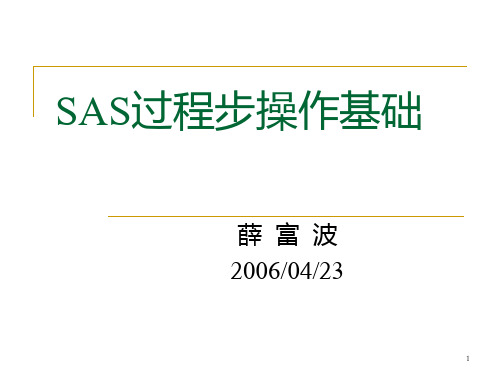
7
报表输出过程
CALENDLOT PRINT REPORT
SQL SUMMARY TABULATE TIMEPLOT
8
统计计算过程
对于指定的SAS数据集,contents过程将列出数据集 的各种属性信息,以及所包含的全部变量及其属性。
有关变量信息的列表将按照字母顺序排列,变量属性 信息包括变量类型、长度、标签以及格式等。
contents过程的一般形式如下: proc contents data=SAS-data-set options; run;
用户所能调用的SAS过程取决于安装SAS时所包含的 模块。
不同的SAS模块包含着执行相应功能的一个或多个 SAS过程。
3
过程步程序的一般结构
以proc语句开始、run语句结束; 过程步程序包含以下三方面的内容:
(1)proc语句,其中包含proc关键字、所要使用的 过程名以及所要处理的数据集等;
FORMAT FSLIST IMPORT OPTIONS OPTLOAD OPTSAVE PDS
PDSCOPY PMENU PRINTTO PRTDEF PRTEXP REGISTRY RELEASE
SORT SOURCE SQL TAPECOPY TAPELABEL TEMPLATE TRANSPOSE
14
print过程
print过程用于将数据集中的全部或特定内容输出显示。 可通过特定语句实现对选定列(变量)和特定行(观
测)的输出显示。 print过程功能特性:自动格式化,以变量名称或标签
为列标题,选择性输出,特定的by格式以及id格式。 print过程的一般形式:
移动应用安全测试技术应用管理技术应用考试 选择题 46题

1. 移动应用安全测试的主要目的是什么?A. 提高应用性能B. 确保应用符合安全标准C. 增加应用功能D. 优化用户界面2. 以下哪项不是移动应用安全测试的常见威胁?A. 数据泄露B. 应用崩溃C. 恶意软件注入D. 中间人攻击3. 在进行移动应用安全测试时,以下哪项是最重要的测试阶段?A. 需求分析B. 测试设计C. 测试执行D. 结果分析4. 静态应用安全测试(SAST)主要用于检测什么?A. 运行时错误B. 代码层面的安全漏洞C. 网络层面的安全漏洞D. 用户界面问题5. 动态应用安全测试(DAST)主要用于检测什么?A. 代码层面的安全漏洞B. 运行时错误C. 网络层面的安全漏洞D. 用户界面问题6. 以下哪项工具通常用于移动应用的静态安全测试?A. Burp SuiteB. OWASP ZAPC. CheckmarxD. Wireshark7. 在进行移动应用安全测试时,以下哪项是最常见的认证机制?A. 双因素认证B. 单因素认证C. 生物识别认证D. 无认证8. 以下哪项不是移动应用安全测试的常见测试类型?A. 渗透测试B. 性能测试C. 合规性测试D. 用户体验测试9. 在进行移动应用安全测试时,以下哪项是最常见的数据保护措施?A. 数据加密B. 数据压缩C. 数据备份D. 数据共享10. 以下哪项不是移动应用安全测试的常见漏洞?A. SQL注入B. 跨站脚本(XSS)C. 缓存溢出D. 跨站请求伪造(CSRF)11. 在进行移动应用安全测试时,以下哪项是最常见的网络攻击类型?A. 拒绝服务攻击(DoS)B. 分布式拒绝服务攻击(DDoS)C. 中间人攻击D. 以上都是12. 以下哪项不是移动应用安全测试的常见测试工具?A. NmapB. MetasploitC. JUnitD. Nessus13. 在进行移动应用安全测试时,以下哪项是最常见的测试环境?A. 物理设备B. 虚拟机C. 模拟器D. 以上都是14. 以下哪项不是移动应用安全测试的常见测试方法?A. 白盒测试B. 黑盒测试C. 灰盒测试D. 蓝盒测试15. 在进行移动应用安全测试时,以下哪项是最常见的测试报告内容?A. 测试结果B. 测试方法C. 测试环境D. 以上都是16. 以下哪项不是移动应用安全测试的常见测试标准?A. OWASPB. ISO 27001C. PCI DSSD. IEEE17. 在进行移动应用安全测试时,以下哪项是最常见的测试策略?A. 自动化测试B. 手动测试C. 混合测试D. 以上都是18. 以下哪项不是移动应用安全测试的常见测试阶段?A. 计划阶段B. 执行阶段C. 报告阶段D. 部署阶段19. 在进行移动应用安全测试时,以下哪项是最常见的测试目标?A. 发现安全漏洞B. 提高应用性能C. 增加应用功能D. 优化用户界面20. 以下哪项不是移动应用安全测试的常见测试技术?A. 渗透测试B. 漏洞扫描C. 性能测试D. 代码审查21. 在进行移动应用安全测试时,以下哪项是最常见的测试工具?A. Burp SuiteB. JUnitC. SeleniumD. Jenkins22. 以下哪项不是移动应用安全测试的常见测试环境?A. 物理设备B. 虚拟机C. 模拟器D. 云环境23. 在进行移动应用安全测试时,以下哪项是最常见的测试方法?A. 白盒测试B. 黑盒测试C. 灰盒测试24. 以下哪项不是移动应用安全测试的常见测试标准?A. OWASPB. ISO 27001C. PCI DSSD. IEEE25. 在进行移动应用安全测试时,以下哪项是最常见的测试策略?A. 自动化测试B. 手动测试C. 混合测试D. 以上都是26. 以下哪项不是移动应用安全测试的常见测试阶段?A. 计划阶段B. 执行阶段C. 报告阶段D. 部署阶段27. 在进行移动应用安全测试时,以下哪项是最常见的测试目标?A. 发现安全漏洞B. 提高应用性能C. 增加应用功能D. 优化用户界面28. 以下哪项不是移动应用安全测试的常见测试技术?A. 渗透测试B. 漏洞扫描C. 性能测试D. 代码审查29. 在进行移动应用安全测试时,以下哪项是最常见的测试工具?A. Burp SuiteB. JUnitC. SeleniumD. Jenkins30. 以下哪项不是移动应用安全测试的常见测试环境?A. 物理设备B. 虚拟机C. 模拟器D. 云环境31. 在进行移动应用安全测试时,以下哪项是最常见的测试方法?A. 白盒测试C. 灰盒测试D. 蓝盒测试32. 以下哪项不是移动应用安全测试的常见测试标准?A. OWASPB. ISO 27001C. PCI DSSD. IEEE33. 在进行移动应用安全测试时,以下哪项是最常见的测试策略?A. 自动化测试B. 手动测试C. 混合测试D. 以上都是34. 以下哪项不是移动应用安全测试的常见测试阶段?A. 计划阶段B. 执行阶段C. 报告阶段D. 部署阶段35. 在进行移动应用安全测试时,以下哪项是最常见的测试目标?A. 发现安全漏洞B. 提高应用性能C. 增加应用功能D. 优化用户界面36. 以下哪项不是移动应用安全测试的常见测试技术?A. 渗透测试B. 漏洞扫描C. 性能测试D. 代码审查37. 在进行移动应用安全测试时,以下哪项是最常见的测试工具?A. Burp SuiteB. JUnitC. SeleniumD. Jenkins38. 以下哪项不是移动应用安全测试的常见测试环境?A. 物理设备B. 虚拟机C. 模拟器D. 云环境39. 在进行移动应用安全测试时,以下哪项是最常见的测试方法?A. 白盒测试B. 黑盒测试C. 灰盒测试D. 蓝盒测试40. 以下哪项不是移动应用安全测试的常见测试标准?A. OWASPB. ISO 27001C. PCI DSSD. IEEE41. 在进行移动应用安全测试时,以下哪项是最常见的测试策略?A. 自动化测试B. 手动测试C. 混合测试D. 以上都是42. 以下哪项不是移动应用安全测试的常见测试阶段?A. 计划阶段B. 执行阶段C. 报告阶段D. 部署阶段43. 在进行移动应用安全测试时,以下哪项是最常见的测试目标?A. 发现安全漏洞B. 提高应用性能C. 增加应用功能D. 优化用户界面44. 以下哪项不是移动应用安全测试的常见测试技术?A. 渗透测试B. 漏洞扫描C. 性能测试D. 代码审查45. 在进行移动应用安全测试时,以下哪项是最常见的测试工具?A. Burp SuiteB. JUnitC. SeleniumD. Jenkins46. 以下哪项不是移动应用安全测试的常见测试环境?A. 物理设备B. 虚拟机C. 模拟器D. 云环境答案1. B2. B3. C4. B5. C6. C7. A8. D9. A10. C11. D12. C13. D14. D15. D16. D17. D18. D19. A20. C21. A22. D23. A24. D25. D26. D27. A28. C29. A30. D31. A32. D33. D34. D35. A36. C37. A38. D39. A40. D41. D42. D43. A44. C45. A46. D。
标准运营程序(SOP)
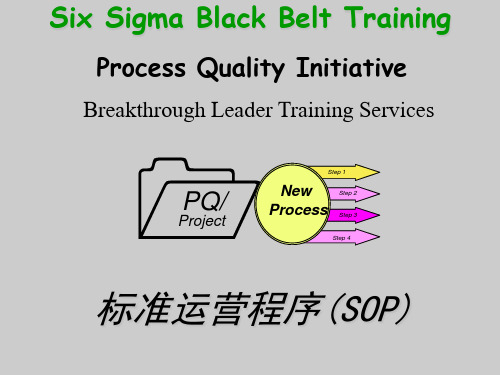
程序/指示
- 规定STEP顺序并决定谁、把什么、在哪里等其他指示事项 - 具体并确实 - 要现实 - 明确成为成果的潜在隐患 - 只要是不平常的事项都要注意
WORK SHEET, 电脑画面, 报告书等的例子
- 包含PROCESS中使用过的所有文件SAMPLE. - 注意文件的确保和查找方法
尽量活用您的TEAM成员以及相关人员
按照文件验证程序
完善而简捷.先进知识(prior knowledge)은 不能估计
适用于容易使用的部分 为继续改善大概抓住完善方法 规定程序进行日期
删除没用的程序
PQI PROJECT
Step 1
NEW
Step 2
PROCESS Step Belt Training
Process Quality Initiative
Breakthrough Leader Training Services
PQ/
Project
Step 1
New
Step 2
Process Step 3
Step 4
标准运营程序(SOP)
目的
按照具体规定的速度行驶. 例: 28, 39, 42, 63 MPH 每个交叉路口都有信号灯
必须沿着道路右侧行驶 限制最高时速 信号灯, 停车标示牌, 让道标示牌
适合你工序的标准化程度是?
PROCESS标准化
因没有标准化而发生的费用
PROCESS散布高 顾客不满足 组织的学习不够 无法维持通过改善所获得的利益 无法统一对业务方法的员工们的认识 需增加必要的监督时间
谁将成为PROCESS的责任人?
品质文件化的特性
标准, 规定遵守 • 要证明最先遵守惯例,遵守可使用的规定 监察的适合性 • 要可视及诚实. • 监察时不问责任所在. • 要明确程序的目的,使之通过检查能够决定是否达到目的.
7QB Training

Plant QRCI
IN UAP QRCI, activities are assigned during review meeting UAP QRCI 在UAP QRCI回顾时分派任务
Line QRCI生产线QRCI: The operators take an action to solve problems immediately! Stop at defect 操作工立刻采取行动解决问题!
GO !
OK/NOK ….
Poka Yoke防错装置
Simple devices to prevent human errors 用简单的防错装置来阻止人的失误
Cell phone Cell phone
•Use ‘red rabbit’ every start of shift to verify poka yoke 使用缺陷样件在开班前确认防错装置 •If not OK: use back up mode or stop production 如果不正常,则使用备份模式或停止生产
7个质量基础培训资料
- -佛吉亚(烟台)
佛吉亚(烟台)公司简介
7个质量基础
仅向下道工序传递合格的零件
质量
Variability Reduction
5S
7个质量基础
供应商伙伴关系 员工授权
标 准 化 工 作
首件
防错
自检
受控返修
红箱
终检
QRCI 快速响应 质量控制
包括缺陷停止
首件合格 检查清单已完成?
5S
Polyvalence 一人多岗 Process Parameters Preventive Maintenance过 程参数和预防性 维护 Product Parameters产品 特性
python 协同训练

python 协同训练一、协同训练概述协同训练(Co-training)是一种半监督学习方法,其主要思想是通过两个或多个学习器相互训练,充分利用不同学习器之间的互补性,提高模型性能。
这种方法在训练过程中,一个学习器使用标签数据进行训练,另一个学习器使用无标签数据进行训练。
它们相互学习,不断更新各自的模型,直到达到预设的迭代次数或收敛条件。
二、协同训练原理协同训练的核心理念是利用不同学习器之间的互补性,提高模型性能。
在训练过程中,一个学习器(称为基学习器)使用有标签数据进行训练,另一个学习器(称为辅助学习器)使用无标签数据进行训练。
基学习器和辅助学习器分别预测无标签数据的标签,然后将预测结果作为辅助学习器的输入,辅助学习器再预测基学习器预测结果的准确性。
这两个过程相互迭代,共同提高模型性能。
三、Python协同训练实例在Python中,我们可以使用scikit-learn库实现协同训练。
以下是一个简单的协同训练实例:```pythonfrom sklearn.datasets import load_irisfrom sklearn.model_selection import train_test_splitfrom sklearn.metrics import accuracy_scorefrom sklearn.ensemble import AdaBoostClassifier# 加载数据iris = load_iris()X, y = iris.data, iris.target# 划分数据集X_train, X_test, y_train, y_test = train_test_split(X, y, test_size=0.5, random_state=42)# 初始化基学习和辅助学习器base_learner = AdaBoostClassifier(n_estimators=50,random_state=42)auxiliary_learner = AdaBoostClassifier(n_estimators=50, random_state=42)# 协同训练for i in range(10):# 基学习器使用有标签数据训练base_learner.fit(X_train, y_train)# 辅助学习器使用无标签数据训练y_pred_base = base_learner.predict(X_test)# 辅助学习器使用基学习器的预测结果作为输入,训练自身auxiliary_learner.fit(X_test, y_pred_base)# 评估基学习器的性能y_pred_aux = auxiliary_learner.predict(X_test)print("基学习器准确性:", accuracy_score(y_test, y_pred_aux))# 评估辅助学习器的性能y_pred_base = base_learner.predict(X_test)print("辅助学习器准确性:", accuracy_score(y_test, y_pred_base)) ```四、协同训练的应用领域协同训练广泛应用于计算机视觉、自然语言处理、生物信息学等领域。
数据安全:数据安全能力成熟度模型之能力成熟度等级描述与GP思维导图
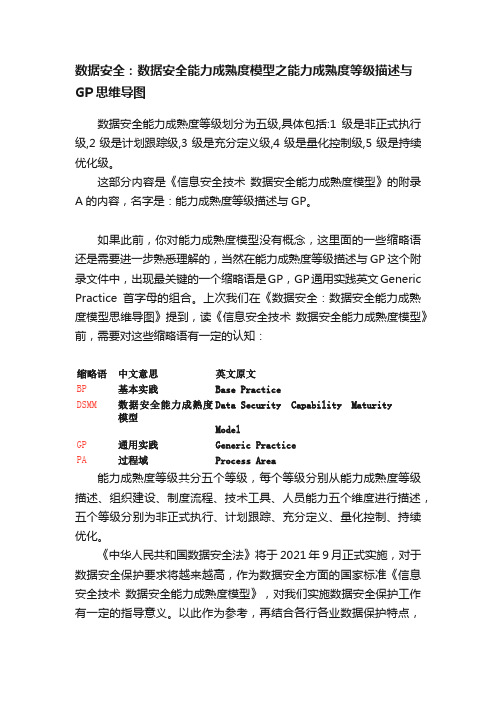
数据安全:数据安全能力成熟度模型之能力成熟度等级描述与GP思维导图数据安全能力成熟度等级划分为五级,具体包括:1级是非正式执行级,2级是计划跟踪级,3级是充分定义级,4级是量化控制级,5级是持续优化级。
这部分内容是《信息安全技术数据安全能力成熟度模型》的附录A的内容,名字是:能力成熟度等级描述与GP。
如果此前,你对能力成熟度模型没有概念,这里面的一些缩略语还是需要进一步熟悉理解的,当然在能力成熟度等级描述与GP这个附录文件中,出现最关键的一个缩略语是GP,GP通用实践英文Generic Practice首字母的组合。
上次我们在《数据安全:数据安全能力成熟度模型思维导图》提到,读《信息安全技术数据安全能力成熟度模型》前,需要对这些缩略语有一定的认知:缩略语中文意思英文原文BP基本实践Base PracticeDSMM数据安全能力成熟度Data Security Capability Maturity 模型ModelGP通用实践Generic PracticePA过程域Process Area能力成熟度等级共分五个等级,每个等级分别从能力成熟度等级描述、组织建设、制度流程、技术工具、人员能力五个维度进行描述,五个等级分别为非正式执行、计划跟踪、充分定义、量化控制、持续优化。
《中华人民共和国数据安全法》将于2021年9月正式实施,对于数据安全保护要求将越来越高,作为数据安全方面的国家标准《信息安全技术数据安全能力成熟度模型》,对我们实施数据安全保护工作有一定的指导意义。
以此作为参考,再结合各行各业数据保护特点,想必可以制定出科学的数据保护实施方案,也能有效提升数据安全防护能力。
参考文献:《信息安全技术数据安全能力成熟度模型》。
ACM-GIS%202006-A%20Peer-to-Peer%20Spatial%20Cloaking%20Algorithm%20for%20Anonymous%20Location-based%
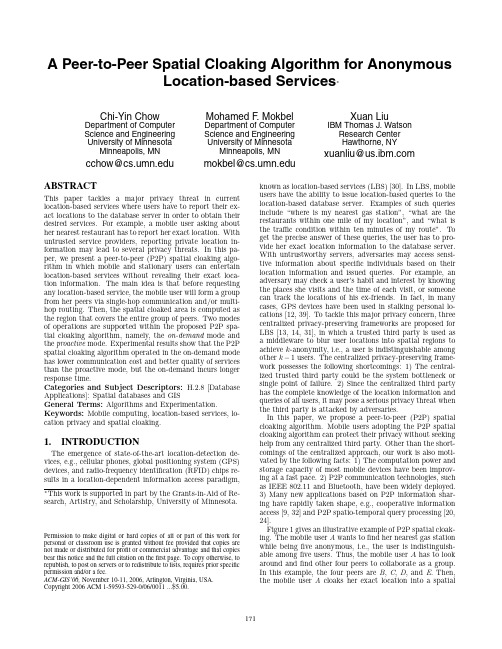
A Peer-to-Peer Spatial Cloaking Algorithm for AnonymousLocation-based Services∗Chi-Yin Chow Department of Computer Science and Engineering University of Minnesota Minneapolis,MN cchow@ Mohamed F.MokbelDepartment of ComputerScience and EngineeringUniversity of MinnesotaMinneapolis,MNmokbel@Xuan LiuIBM Thomas J.WatsonResearch CenterHawthorne,NYxuanliu@ABSTRACTThis paper tackles a major privacy threat in current location-based services where users have to report their ex-act locations to the database server in order to obtain their desired services.For example,a mobile user asking about her nearest restaurant has to report her exact location.With untrusted service providers,reporting private location in-formation may lead to several privacy threats.In this pa-per,we present a peer-to-peer(P2P)spatial cloaking algo-rithm in which mobile and stationary users can entertain location-based services without revealing their exact loca-tion information.The main idea is that before requesting any location-based service,the mobile user will form a group from her peers via single-hop communication and/or multi-hop routing.Then,the spatial cloaked area is computed as the region that covers the entire group of peers.Two modes of operations are supported within the proposed P2P spa-tial cloaking algorithm,namely,the on-demand mode and the proactive mode.Experimental results show that the P2P spatial cloaking algorithm operated in the on-demand mode has lower communication cost and better quality of services than the proactive mode,but the on-demand incurs longer response time.Categories and Subject Descriptors:H.2.8[Database Applications]:Spatial databases and GISGeneral Terms:Algorithms and Experimentation. Keywords:Mobile computing,location-based services,lo-cation privacy and spatial cloaking.1.INTRODUCTIONThe emergence of state-of-the-art location-detection de-vices,e.g.,cellular phones,global positioning system(GPS) devices,and radio-frequency identification(RFID)chips re-sults in a location-dependent information access paradigm,∗This work is supported in part by the Grants-in-Aid of Re-search,Artistry,and Scholarship,University of Minnesota. Permission to make digital or hard copies of all or part of this work for personal or classroom use is granted without fee provided that copies are not made or distributed for profit or commercial advantage and that copies bear this notice and the full citation on thefirst page.To copy otherwise,to republish,to post on servers or to redistribute to lists,requires prior specific permission and/or a fee.ACM-GIS’06,November10-11,2006,Arlington,Virginia,USA. Copyright2006ACM1-59593-529-0/06/0011...$5.00.known as location-based services(LBS)[30].In LBS,mobile users have the ability to issue location-based queries to the location-based database server.Examples of such queries include“where is my nearest gas station”,“what are the restaurants within one mile of my location”,and“what is the traffic condition within ten minutes of my route”.To get the precise answer of these queries,the user has to pro-vide her exact location information to the database server. With untrustworthy servers,adversaries may access sensi-tive information about specific individuals based on their location information and issued queries.For example,an adversary may check a user’s habit and interest by knowing the places she visits and the time of each visit,or someone can track the locations of his ex-friends.In fact,in many cases,GPS devices have been used in stalking personal lo-cations[12,39].To tackle this major privacy concern,three centralized privacy-preserving frameworks are proposed for LBS[13,14,31],in which a trusted third party is used as a middleware to blur user locations into spatial regions to achieve k-anonymity,i.e.,a user is indistinguishable among other k−1users.The centralized privacy-preserving frame-work possesses the following shortcomings:1)The central-ized trusted third party could be the system bottleneck or single point of failure.2)Since the centralized third party has the complete knowledge of the location information and queries of all users,it may pose a serious privacy threat when the third party is attacked by adversaries.In this paper,we propose a peer-to-peer(P2P)spatial cloaking algorithm.Mobile users adopting the P2P spatial cloaking algorithm can protect their privacy without seeking help from any centralized third party.Other than the short-comings of the centralized approach,our work is also moti-vated by the following facts:1)The computation power and storage capacity of most mobile devices have been improv-ing at a fast pace.2)P2P communication technologies,such as IEEE802.11and Bluetooth,have been widely deployed.3)Many new applications based on P2P information shar-ing have rapidly taken shape,e.g.,cooperative information access[9,32]and P2P spatio-temporal query processing[20, 24].Figure1gives an illustrative example of P2P spatial cloak-ing.The mobile user A wants tofind her nearest gas station while beingfive anonymous,i.e.,the user is indistinguish-able amongfive users.Thus,the mobile user A has to look around andfind other four peers to collaborate as a group. In this example,the four peers are B,C,D,and E.Then, the mobile user A cloaks her exact location into a spatialA B CDEBase Stationregion that covers the entire group of mobile users A ,B ,C ,D ,and E .The mobile user A randomly selects one of the mobile users within the group as an agent .In the ex-ample given in Figure 1,the mobile user D is selected as an agent.Then,the mobile user A sends her query (i.e.,what is the nearest gas station)along with her cloaked spa-tial region to the agent.The agent forwards the query to the location-based database server through a base station.Since the location-based database server processes the query based on the cloaked spatial region,it can only give a list of candidate answers that includes the actual answers and some false positives.After the agent receives the candidate answers,it forwards the candidate answers to the mobile user A .Finally,the mobile user A gets the actual answer by filtering out all the false positives.The proposed P2P spatial cloaking algorithm can operate in two modes:on-demand and proactive .In the on-demand mode,mobile clients execute the cloaking algorithm when they need to access information from the location-based database server.On the other side,in the proactive mode,mobile clients periodically look around to find the desired number of peers.Thus,they can cloak their exact locations into spatial regions whenever they want to retrieve informa-tion from the location-based database server.In general,the contributions of this paper can be summarized as follows:1.We introduce a distributed system architecture for pro-viding anonymous location-based services (LBS)for mobile users.2.We propose the first P2P spatial cloaking algorithm for mobile users to entertain high quality location-based services without compromising their privacy.3.We provide experimental evidence that our proposed algorithm is efficient in terms of the response time,is scalable to large numbers of mobile clients,and is effective as it provides high-quality services for mobile clients without the need of exact location information.The rest of this paper is organized as follows.Section 2highlights the related work.The system model of the P2P spatial cloaking algorithm is presented in Section 3.The P2P spatial cloaking algorithm is described in Section 4.Section 5discusses the integration of the P2P spatial cloak-ing algorithm with privacy-aware location-based database servers.Section 6depicts the experimental evaluation of the P2P spatial cloaking algorithm.Finally,Section 7con-cludes this paper.2.RELATED WORKThe k -anonymity model [37,38]has been widely used in maintaining privacy in databases [5,26,27,28].The main idea is to have each tuple in the table as k -anonymous,i.e.,indistinguishable among other k −1tuples.Although we aim for the similar k -anonymity model for the P2P spatial cloaking algorithm,none of these techniques can be applied to protect user privacy for LBS,mainly for the following four reasons:1)These techniques preserve the privacy of the stored data.In our model,we aim not to store the data at all.Instead,we store perturbed versions of the data.Thus,data privacy is managed before storing the data.2)These approaches protect the data not the queries.In anonymous LBS,we aim to protect the user who issues the query to the location-based database server.For example,a mobile user who wants to ask about her nearest gas station needs to pro-tect her location while the location information of the gas station is not protected.3)These approaches guarantee the k -anonymity for a snapshot of the database.In LBS,the user location is continuously changing.Such dynamic be-havior calls for continuous maintenance of the k -anonymity model.(4)These approaches assume a unified k -anonymity requirement for all the stored records.In our P2P spatial cloaking algorithm,k -anonymity is a user-specified privacy requirement which may have a different value for each user.Motivated by the privacy threats of location-detection de-vices [1,4,6,40],several research efforts are dedicated to protect the locations of mobile users (e.g.,false dummies [23],landmark objects [18],and location perturbation [10,13,14]).The most closed approaches to ours are two centralized spatial cloaking algorithms,namely,the spatio-temporal cloaking [14]and the CliqueCloak algorithm [13],and one decentralized privacy-preserving algorithm [23].The spatio-temporal cloaking algorithm [14]assumes that all users have the same k -anonymity requirements.Furthermore,it lacks the scalability because it deals with each single request of each user individually.The CliqueCloak algorithm [13]as-sumes a different k -anonymity requirement for each user.However,since it has large computation overhead,it is lim-ited to a small k -anonymity requirement,i.e.,k is from 5to 10.A decentralized privacy-preserving algorithm is proposed for LBS [23].The main idea is that the mobile client sends a set of false locations,called dummies ,along with its true location to the location-based database server.However,the disadvantages of using dummies are threefold.First,the user has to generate realistic dummies to pre-vent the adversary from guessing its true location.Second,the location-based database server wastes a lot of resources to process the dummies.Finally,the adversary may esti-mate the user location by using cellular positioning tech-niques [34],e.g.,the time-of-arrival (TOA),the time differ-ence of arrival (TDOA)and the direction of arrival (DOA).Although several existing distributed group formation al-gorithms can be used to find peers in a mobile environment,they are not designed for privacy preserving in LBS.Some algorithms are limited to only finding the neighboring peers,e.g.,lowest-ID [11],largest-connectivity (degree)[33]and mobility-based clustering algorithms [2,25].When a mo-bile user with a strict privacy requirement,i.e.,the value of k −1is larger than the number of neighboring peers,it has to enlist other peers for help via multi-hop routing.Other algorithms do not have this limitation,but they are designed for grouping stable mobile clients together to facil-Location-based Database ServerDatabase ServerDatabase ServerFigure 2:The system architectureitate efficient data replica allocation,e.g.,dynamic connec-tivity based group algorithm [16]and mobility-based clus-tering algorithm,called DRAM [19].Our work is different from these approaches in that we propose a P2P spatial cloaking algorithm that is dedicated for mobile users to dis-cover other k −1peers via single-hop communication and/or via multi-hop routing,in order to preserve user privacy in LBS.3.SYSTEM MODELFigure 2depicts the system architecture for the pro-posed P2P spatial cloaking algorithm which contains two main components:mobile clients and location-based data-base server .Each mobile client has its own privacy profile that specifies its desired level of privacy.A privacy profile includes two parameters,k and A min ,k indicates that the user wants to be k -anonymous,i.e.,indistinguishable among k users,while A min specifies the minimum resolution of the cloaked spatial region.The larger the value of k and A min ,the more strict privacy requirements a user needs.Mobile users have the ability to change their privacy profile at any time.Our employed privacy profile matches the privacy re-quirements of mobiles users as depicted by several social science studies (e.g.,see [4,15,17,22,29]).In this architecture,each mobile user is equipped with two wireless network interface cards;one of them is dedicated to communicate with the location-based database server through the base station,while the other one is devoted to the communication with other peers.A similar multi-interface technique has been used to implement IP multi-homing for stream control transmission protocol (SCTP),in which a machine is installed with multiple network in-terface cards,and each assigned a different IP address [36].Similarly,in mobile P2P cooperation environment,mobile users have a network connection to access information from the server,e.g.,through a wireless modem or a base station,and the mobile users also have the ability to communicate with other peers via a wireless LAN,e.g.,IEEE 802.11or Bluetooth [9,24,32].Furthermore,each mobile client is equipped with a positioning device, e.g.,GPS or sensor-based local positioning systems,to determine its current lo-cation information.4.P2P SPATIAL CLOAKINGIn this section,we present the data structure and the P2P spatial cloaking algorithm.Then,we describe two operation modes of the algorithm:on-demand and proactive .4.1Data StructureThe entire system area is divided into grid.The mobile client communicates with each other to discover other k −1peers,in order to achieve the k -anonymity requirement.TheAlgorithm 1P2P Spatial Cloaking:Request Originator m 1:Function P2PCloaking-Originator (h ,k )2://Phase 1:Peer searching phase 3:The hop distance h is set to h4:The set of discovered peers T is set to {∅},and the number ofdiscovered peers k =|T |=05:while k <k −1do6:Broadcast a FORM GROUP request with the parameter h (Al-gorithm 2gives the response of each peer p that receives this request)7:T is the set of peers that respond back to m by executingAlgorithm 28:k =|T |;9:if k <k −1then 10:if T =T then 11:Suspend the request 12:end if 13:h ←h +1;14:T ←T ;15:end if 16:end while17://Phase 2:Location adjustment phase 18:for all T i ∈T do19:|mT i .p |←the greatest possible distance between m and T i .pby considering the timestamp of T i .p ’s reply and maximum speed20:end for21://Phase 3:Spatial cloaking phase22:Form a group with k −1peers having the smallest |mp |23:h ←the largest hop distance h p of the selected k −1peers 24:Determine a grid area A that covers the entire group 25:if A <A min then26:Extend the area of A till it covers A min 27:end if28:Randomly select a mobile client of the group as an agent 29:Forward the query and A to the agentmobile client can thus blur its exact location into a cloaked spatial region that is the minimum grid area covering the k −1peers and itself,and satisfies A min as well.The grid area is represented by the ID of the left-bottom and right-top cells,i.e.,(l,b )and (r,t ).In addition,each mobile client maintains a parameter h that is the required hop distance of the last peer searching.The initial value of h is equal to one.4.2AlgorithmFigure 3gives a running example for the P2P spatial cloaking algorithm.There are 15mobile clients,m 1to m 15,represented as solid circles.m 8is the request originator,other black circles represent the mobile clients received the request from m 8.The dotted circles represent the commu-nication range of the mobile client,and the arrow represents the movement direction.Algorithms 1and 2give the pseudo code for the request originator (denoted as m )and the re-quest receivers (denoted as p ),respectively.In general,the algorithm consists of the following three phases:Phase 1:Peer searching phase .The request origina-tor m wants to retrieve information from the location-based database server.m first sets h to h ,a set of discovered peers T to {∅}and the number of discovered peers k to zero,i.e.,|T |.(Lines 3to 4in Algorithm 1).Then,m broadcasts a FORM GROUP request along with a message sequence ID and the hop distance h to its neighboring peers (Line 6in Algorithm 1).m listens to the network and waits for the reply from its neighboring peers.Algorithm 2describes how a peer p responds to the FORM GROUP request along with a hop distance h and aFigure3:P2P spatial cloaking algorithm.Algorithm2P2P Spatial Cloaking:Request Receiver p1:Function P2PCloaking-Receiver(h)2://Let r be the request forwarder3:if the request is duplicate then4:Reply r with an ACK message5:return;6:end if7:h p←1;8:if h=1then9:Send the tuple T=<p,(x p,y p),v maxp ,t p,h p>to r10:else11:h←h−1;12:Broadcast a FORM GROUP request with the parameter h 13:T p is the set of peers that respond back to p14:for all T i∈T p do15:T i.h p←T i.h p+1;16:end for17:T p←T p∪{<p,(x p,y p),v maxp ,t p,h p>};18:Send T p back to r19:end ifmessage sequence ID from another peer(denoted as r)that is either the request originator or the forwarder of the re-quest.First,p checks if it is a duplicate request based on the message sequence ID.If it is a duplicate request,it sim-ply replies r with an ACK message without processing the request.Otherwise,p processes the request based on the value of h:Case1:h= 1.p turns in a tuple that contains its ID,current location,maximum movement speed,a timestamp and a hop distance(it is set to one),i.e.,< p,(x p,y p),v max p,t p,h p>,to r(Line9in Algorithm2). Case2:h> 1.p decrements h and broadcasts the FORM GROUP request with the updated h and the origi-nal message sequence ID to its neighboring peers.p keeps listening to the network,until it collects the replies from all its neighboring peers.After that,p increments the h p of each collected tuple,and then it appends its own tuple to the collected tuples T p.Finally,it sends T p back to r (Lines11to18in Algorithm2).After m collects the tuples T from its neighboring peers, if m cannotfind other k−1peers with a hop distance of h,it increments h and re-broadcasts the FORM GROUP request along with a new message sequence ID and h.m repeatedly increments h till itfinds other k−1peers(Lines6to14in Algorithm1).However,if mfinds the same set of peers in two consecutive broadcasts,i.e.,with hop distances h and h+1,there are not enough connected peers for m.Thus, m has to relax its privacy profile,i.e.,use a smaller value of k,or to be suspended for a period of time(Line11in Algorithm1).Figures3(a)and3(b)depict single-hop and multi-hop peer searching in our running example,respectively.In Fig-ure3(a),the request originator,m8,(e.g.,k=5)canfind k−1peers via single-hop communication,so m8sets h=1. Since h=1,its neighboring peers,m5,m6,m7,m9,m10, and m11,will not further broadcast the FORM GROUP re-quest.On the other hand,in Figure3(b),m8does not connect to k−1peers directly,so it has to set h>1.Thus, its neighboring peers,m7,m10,and m11,will broadcast the FORM GROUP request along with a decremented hop dis-tance,i.e.,h=h−1,and the original message sequence ID to their neighboring peers.Phase2:Location adjustment phase.Since the peer keeps moving,we have to capture the movement between the time when the peer sends its tuple and the current time. For each received tuple from a peer p,the request originator, m,determines the greatest possible distance between them by an equation,|mp |=|mp|+(t c−t p)×v max p,where |mp|is the Euclidean distance between m and p at time t p,i.e.,|mp|=(x m−x p)2+(y m−y p)2,t c is the currenttime,t p is the timestamp of the tuple and v maxpis the maximum speed of p(Lines18to20in Algorithm1).In this paper,a conservative approach is used to determine the distance,because we assume that the peer will move with the maximum speed in any direction.If p gives its movement direction,m has the ability to determine a more precise distance between them.Figure3(c)illustrates that,for each discovered peer,the circle represents the largest region where the peer can lo-cate at time t c.The greatest possible distance between the request originator m8and its discovered peer,m5,m6,m7, m9,m10,or m11is represented by a dotted line.For exam-ple,the distance of the line m8m 11is the greatest possible distance between m8and m11at time t c,i.e.,|m8m 11|. Phase3:Spatial cloaking phase.In this phase,the request originator,m,forms a virtual group with the k−1 nearest peers,based on the greatest possible distance be-tween them(Line22in Algorithm1).To adapt to the dynamic network topology and k-anonymity requirement, m sets h to the largest value of h p of the selected k−1 peers(Line15in Algorithm1).Then,m determines the minimum grid area A covering the entire group(Line24in Algorithm1).If the area of A is less than A min,m extends A,until it satisfies A min(Lines25to27in Algorithm1). Figure3(c)gives the k−1nearest peers,m6,m7,m10,and m11to the request originator,m8.For example,the privacy profile of m8is(k=5,A min=20cells),and the required cloaked spatial region of m8is represented by a bold rectan-gle,as depicted in Figure3(d).To issue the query to the location-based database server anonymously,m randomly selects a mobile client in the group as an agent(Line28in Algorithm1).Then,m sendsthe query along with the cloaked spatial region,i.e.,A,to the agent(Line29in Algorithm1).The agent forwards thequery to the location-based database server.After the serverprocesses the query with respect to the cloaked spatial re-gion,it sends a list of candidate answers back to the agent.The agent forwards the candidate answer to m,and then mfilters out the false positives from the candidate answers. 4.3Modes of OperationsThe P2P spatial cloaking algorithm can operate in twomodes,on-demand and proactive.The on-demand mode:The mobile client only executesthe algorithm when it needs to retrieve information from the location-based database server.The algorithm operatedin the on-demand mode generally incurs less communica-tion overhead than the proactive mode,because the mobileclient only executes the algorithm when necessary.However,it suffers from a longer response time than the algorithm op-erated in the proactive mode.The proactive mode:The mobile client adopting theproactive mode periodically executes the algorithm in back-ground.The mobile client can cloak its location into a spa-tial region immediately,once it wants to communicate withthe location-based database server.The proactive mode pro-vides a better response time than the on-demand mode,but it generally incurs higher communication overhead and giveslower quality of service than the on-demand mode.5.ANONYMOUS LOCATION-BASEDSERVICESHaving the spatial cloaked region as an output form Algo-rithm1,the mobile user m sends her request to the location-based server through an agent p that is randomly selected.Existing location-based database servers can support onlyexact point locations rather than cloaked regions.In or-der to be able to work with a spatial region,location-basedservers need to be equipped with a privacy-aware queryprocessor(e.g.,see[29,31]).The main idea of the privacy-aware query processor is to return a list of candidate answerrather than the exact query answer.Then,the mobile user m willfilter the candidate list to eliminate its false positives andfind its exact answer.The tighter the spatial cloaked re-gion,the lower is the size of the candidate answer,and hencethe better is the performance of the privacy-aware query processor.However,tight cloaked regions may represent re-laxed privacy constrained.Thus,a trade-offbetween the user privacy and the quality of service can be achieved[31]. Figure4(a)depicts such scenario by showing the data stored at the server side.There are32target objects,i.e., gas stations,T1to T32represented as black circles,the shaded area represents the spatial cloaked area of the mo-bile client who issued the query.For clarification,the actual mobile client location is plotted in Figure4(a)as a black square inside the cloaked area.However,such information is neither stored at the server side nor revealed to the server. The privacy-aware query processor determines a range that includes all target objects that are possibly contributing to the answer given that the actual location of the mobile client could be anywhere within the shaded area.The range is rep-resented as a bold rectangle,as depicted in Figure4(b).The server sends a list of candidate answers,i.e.,T8,T12,T13, T16,T17,T21,and T22,back to the agent.The agent next for-(a)Server Side(b)Client SideFigure4:Anonymous location-based services wards the candidate answers to the requesting mobile client either through single-hop communication or through multi-hop routing.Finally,the mobile client can get the actualanswer,i.e.,T13,byfiltering out the false positives from thecandidate answers.The algorithmic details of the privacy-aware query proces-sor is beyond the scope of this paper.Interested readers are referred to[31]for more details.6.EXPERIMENTAL RESULTSIn this section,we evaluate and compare the scalabilityand efficiency of the P2P spatial cloaking algorithm in boththe on-demand and proactive modes with respect to the av-erage response time per query,the average number of mes-sages per query,and the size of the returned candidate an-swers from the location-based database server.The queryresponse time in the on-demand mode is defined as the timeelapsed between a mobile client starting to search k−1peersand receiving the candidate answers from the agent.On theother hand,the query response time in the proactive mode is defined as the time elapsed between a mobile client startingto forward its query along with the cloaked spatial regionto the agent and receiving the candidate answers from theagent.The simulation model is implemented in C++usingCSIM[35].In all the experiments in this section,we consider an in-dividual random walk model that is based on“random way-point”model[7,8].At the beginning,the mobile clientsare randomly distributed in a spatial space of1,000×1,000square meters,in which a uniform grid structure of100×100cells is constructed.Each mobile client randomly chooses itsown destination in the space with a randomly determined speed s from a uniform distribution U(v min,v max).When the mobile client reaches the destination,it comes to a stand-still for one second to determine its next destination.Afterthat,the mobile client moves towards its new destinationwith another speed.All the mobile clients repeat this move-ment behavior during the simulation.The time interval be-tween two consecutive queries generated by a mobile client follows an exponential distribution with a mean of ten sec-onds.All the experiments consider one half-duplex wirelesschannel for a mobile client to communicate with its peers with a total bandwidth of2Mbps and a transmission range of250meters.When a mobile client wants to communicate with other peers or the location-based database server,it has to wait if the requested channel is busy.In the simulated mobile environment,there is a centralized location-based database server,and one wireless communication channel between the location-based database server and the mobile。
六西格玛最新教材

销售 纳期延期
过多
不必要的快递
未正确完成销售定单
计划延迟
文件延迟
投诉接待人员
顾客信用度失去
人员流动过于频繁
未使用的能力
事务
对现状缺乏跟踪
过多
6σ 活动概念 3. 6σ活动 本质
▶ Macro
with Micro
!
▶ Working
! Not Working
!
▶ Do it Right First Time !
Exercise: PROCESS MAPPING 请描述你现在的业务过程
统计和业务 3.相互关联的业务流程:SIPOC
投入物
过程
供给者
产出物
顾客
统计和业务
PS: 内部/外部顾客需求
供应商
We Must
vs
做
we Can
顾客
Needs
需要
vs
Wants
我们力求在工时,成本及品质等方面的能力能 满足顾客对交付,价格及品质的期望.
所谓σ 水平就是指标准段内可包含的标准偏差的个数。
☞ 改善后标准偏差将得到改善,那么Sigma 水平又将如何变化呢?
若由5分缩减为2.5分,则变为2 Sigma Level。
若再缩减为一分的话,则变为5 Sigma Level。
标准偏差
也可看作向顾客提供的品质好。
业务水平与 6σ
2. 6σ的含义
☞ 将各个Sigma Level 进行具体数值化比较的结果如下…
• 收集数据证实问 题及过程
• 测量关键问题
• 确定关键因素的根 本原因。
• 验证假设
• 树立改善根本原因 的对策。
• 测量效果
机器学习模型的调试和评估方法
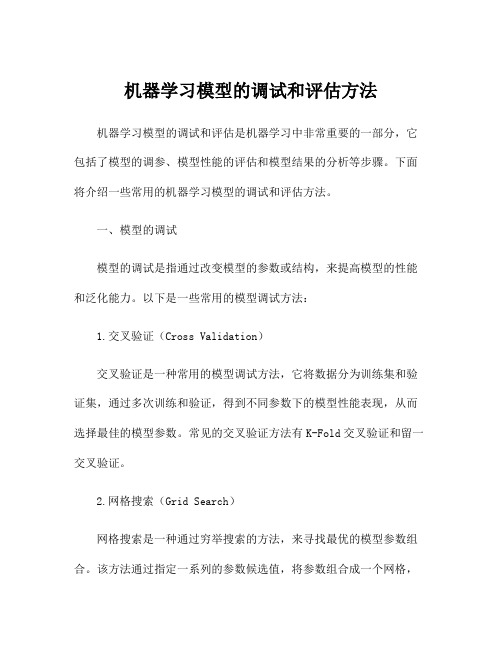
机器学习模型的调试和评估方法机器学习模型的调试和评估是机器学习中非常重要的一部分,它包括了模型的调参、模型性能的评估和模型结果的分析等步骤。
下面将介绍一些常用的机器学习模型的调试和评估方法。
一、模型的调试模型的调试是指通过改变模型的参数或结构,来提高模型的性能和泛化能力。
以下是一些常用的模型调试方法:1.交叉验证(Cross Validation)交叉验证是一种常用的模型调试方法,它将数据分为训练集和验证集,通过多次训练和验证,得到不同参数下的模型性能表现,从而选择最佳的模型参数。
常见的交叉验证方法有K-Fold交叉验证和留一交叉验证。
2.网格搜索(Grid Search)网格搜索是一种通过穷举搜索的方法,来寻找最优的模型参数组合。
该方法通过指定一系列的参数候选值,将参数组合成一个网格,计算每个参数组合的模型性能,选择性能最好的参数组合作为最佳模型参数。
3.随机搜索(Random Search)随机搜索是一种通过随机抽样的方法,在参数的搜索空间中随机选择参数组合进行训练和评估。
相较于网格搜索,随机搜索的主要优势在于可以更快地寻找到较优的参数组合,尤其在参数空间较大时,随机搜索的效率更高。
4.提前停止(Early Stopping)提前停止是一种通过观察模型在验证集上的性能变化来判断何时停止训练。
通常情况下,训练误差会随着迭代次数的增加而逐渐减小,而验证误差则在达到一定阈值之后开始增大。
当验证误差超过一定阈值时,可以停止训练,以避免模型过拟合。
5.特征选择(Feature Selection)特征选择是一种通过选择最有用的特征子集来降低模型的复杂度和提高模型性能的方法。
常见的特征选择方法有过滤法、包装法和嵌入法等。
二、模型性能的评估模型性能的评估是指对模型在未知数据上的预测能力进行评估的过程。
以下是一些常用的模型性能评估方法:1.准确率(Accuracy)准确率是指模型在所有预测样本中预测正确的比例。
- 1、下载文档前请自行甄别文档内容的完整性,平台不提供额外的编辑、内容补充、找答案等附加服务。
- 2、"仅部分预览"的文档,不可在线预览部分如存在完整性等问题,可反馈申请退款(可完整预览的文档不适用该条件!)。
- 3、如文档侵犯您的权益,请联系客服反馈,我们会尽快为您处理(人工客服工作时间:9:00-18:30)。
Automotive Systems Quality Management SABS Supplier Quality Assurance
Automotive Systems Quality Management SABS Supplier Quality Assurance
1
产品定义 Product Definition
1.2 产品定义过程描述
1.2.5 可行性分析 可行性分析: -- 缺陷或风险必须制定措施纠正. 可行性分析表> -- 可行性分析结果填入<AQP 可行性分析表 1.2.6 设计验证计划 设计验证计划: -- 仅适用于有产品设计职责的供应商. -- 设计验证计划必须经SABS 同意. 1.2.7 产品定义阶段工作检查: -- 检查确认1.1项目中规定的所有项目全部完成. 状态报告>1 -- 检查结果及措施填入<AQP状态报告 状态报告 -- 针对问题必须制定措施.填入 <AQP CCAR> 1.2.8 在对产品和顾客要求进行充分分析,证明能满足这些要求之后,可转入产品确认阶段.
Automotive Systems Quality Management SABS Supplier Quality Assurance
1
产品定义 Product Definition
1.2 产品定义过程描述
1.2.1 项目启动后,SABS 采购部填写 <AQP信息表>, 并连同相关技术文件发至供应商 < AQP信息表 信息表> 信息表 1.2.2 供应商在收到<AQP信息表>后,进行信确认,在8个工作日内向SABS 采购部回复以下内容: -- 项目时间进度表 -- 可行性分析表 -- 补充且签字的AQP信息表 1.2.3 项目时间进度表 项目时间进度表: -- 供应商根据<AQP信息表>,使用甘特图制定<项目时间进度表>. -- 任何项目更改必须更新时间进度表。 1.2.4 设计 设计FMEA: -- 仅适用于有产品设计职责的供应商.
1
产品确认 Product Validation
1.1 产品确认阶段供应商的主要工作 产品确认阶段供应商的主要工作: 手工样品控制计划 工艺流程图 过程FMEA 过程FMEA 控制计划 能力规划
Automotive Systems Quality Management SABS Supplier Quality Assurance
概念
产品开发 设计验证试 验 过程开发 手工样品过程 批量过程 过程验 证
过程验证试验 试运行
PPAP
过程验证计划 作业指导书/培训计划 短期过程能力 供应商AQP状态 包装计划
重要时间点
认可
项目信息
手工样品工装采购
批量样品工装采购
试运行
批量生产(PPAP)
图2:产品定义 图1:项目流程
Automotive Systems Quality Management SABS Supplier Quality Assurance
Automotive Systems Quality Management SABS Supplier Quality Assurance
2
产品确认 Product Validation
阶段 Phases 任务 Activities 产品定义 Product Definition 产品确认 Product Validation 过程确认 Process Validation 试运行 / PPAP Trial Run / PPAP 批产 Series
产品开发 Product development
设计验证 试验 Design Validation 过程开发 Process(DV) Test development
手工样品过程 Prototype Process 批量过程 Series Process
五个关键控制点: 五个关键控制点:
1. 2. 3. 4. 5. 项目信息确定 手工样品工装采购认可 批量样品工装采购认可 试运行认可 批量生产认可
1
产品定义 Product Definition
1.1 产品定义阶段供应商的主要工作 产品定义阶段供应商的主要工作: 项目时间进度表 设计FEMA 设计FEMA 可行性分析 设计验证计划
Automotive Systems Quality Management SABS Supplier Quality Assurance
3
过程确认 Process Validation
3.2 过程确认过程描述 过程确认过程描述: 关键特性定义表>内. 3.2.1过程特性必须得到确认.并记录于<AQP关键特性定义表 关键特性定义表 3.2.2 过程验证计划 过程验证计划: -- 必须经SABS同意 -- 由于供应商缺少检测设备而无法做的检测必须指明. 3.2.3 作业指导书 作业指导书: -- 必须挂在工位的显著位置,工作内容应清晰可见. -- 各工位关键的地方应明显标出. -- 已知的问题和顾客抱怨也要说明. 3.2.4 培训计划 -- 制定培训计划保证被培训人员在试运行时能胜任工作 3.2.5 供应商 供应商AQP 状态 -- 供应商必须保证其供应商也实施的AQP. -- 如果供应商没有自己的系统,则应使用SABS的记录表式。
Proces s Validat ion
过程 验证
过程验证试验 Process Validation (PV) Tests
试运行 Trial Run
PPAP
重要时间点 Milestones
认可 Releases 图1:项目流程
项目信息 Project Info
手工样品工装 Prototype Tools
AQP 过程培训
ห้องสมุดไป่ตู้
SABS
质 量 培 训 供 应 商 AQP过程 (产品质量先期策划过程)
SABS SQA 团队
Automotive Systems Quality Management SABS Supplier Quality Assurance
AQP 过程培训目的
Automotive Systems Quality Management SABS Supplier Quality Assurance
Automotive Systems Quality Management SABS Supplier Quality Assurance
3
过程确认 Process Validation
阶段 Phases 任务 Activities 产品定义 Product Definition 产品确认 Product Validation 过程确认 Process Validation 试运行 / PPAP Trial Run / PPAP 批产 Series
1. 2. 3. 4. 产品定义阶段 产品确认阶段 过程确认阶段 试运行/PPAP阶段
阶段 Phases
概念 Concepts
产品定义 Product Definition 产品确认 Product Validation 过程确认 Process Validation 试运行 / PPAP Trial Run / PPAP 批产 Series
3.2.7 短期过程能力 -- 短期过程能力分析将依据已经确定的“D”和“W”特性进行 -- 过程必须完全受控 ,否则优化期间必须100%检验 -- 短期过程能力Cmk ≥ 1.67,则具备短期过程能力。 3.2.8 过程确认阶段的检查 过程确认阶段的检查: -- 检查确认3.1项目中规定的所有工作全部完成. -- 检查结果及措施填入<AQP状态报告 状态报告>3 状态报告 -- 针对问题必须制定措施.填入 <AQP CCAR> 3.2.9 过程验证生产的零件除用于短期能力分析外,可作为OTS 样件提交SABS进行零件认可。
1
产品定义 Product Definition
阶段 Phases 任务 Activities 产品定义 Product Definition 产品确认 Product Validation 过程确认 Process Validation 试运行 / PPAP Trial Run / PPAP 批产 Series
概念
产品开发 设计验证试 验 过程开发 手工样品过程 批量过程 过程验 证
过程验证试验 试运行
PPAP
手工样品控制计划 工艺流程图 过程FMEA 控制计划 能力规划
重要时间点
认可
项目信息
手工样品工装采购
批量样品工装采购
试运行
批量生产(PPAP)
图2:产品定义 图1:项目流程
Automotive Systems Quality Management SABS Supplier Quality Assurance
AQP 过程培训内容
0 1 2 3 4
AQP过程 产品定义 产品确认 过程确认 试运行/PPAP
Automotive Systems Quality Management SABS Supplier Quality Assurance
0
AQP 过程描述
AQP:新项目启动到产品批量的质量先期策划整个过程,过程定义了4个阶段. 四个阶段: 四个阶段:
批量样品工装(OTS) 批量样品工装 Series Equipment (OTS)
试运行(过程认可 试运行 过程认可) 过程认可 Trial Run
批量生产(PPAP) 批量生产 Series Production
